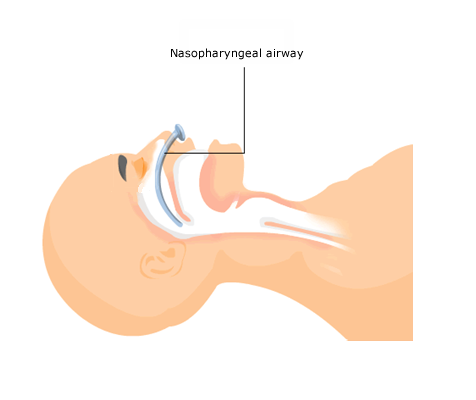Nasal Intubation
Note that the widest part of the nasal airway is below the inferior turbinate, which projects from the lateral wall of the nose.
During nasal intubation, the tracheal tube is passed backwards along the floor of the nose beneath the inferior turbinate, which may offer some resistance. Use gentle pressure to avoid nosebleeds. Fig 1 shows the path of nasal intubation.
Once in the nasopharynx, the tracheal tube must be curved anteriorly. Magill's forceps are often required to direct the tube between the cords.
Question: What are the advantages of nasal intubation?

Note that the widest part of the nasal airway is below the inferior turbinate, which projects from the lateral wall of the nose.
During nasal intubation, the tracheal tube is passed backwards along the floor of the nose beneath the inferior turbinate, which may offer some resistance. Use gentle pressure to avoid nosebleeds. Fig 1 shows the path of nasal intubation.
Once in the nasopharynx, the tracheal tube must be curved anteriorly. Magill's forceps are often required to direct the tube between the cords.
Question: What are the advantages of nasal intubation?
Answer: Nasal intubation leaves the oral cavity clear for oral surgery.
For patients in the Intensive Care Unit (ICU), nasal intubation is more easily tolerated than oral intubation and less sedation is required.
Question: What are the disadvantages of nasal intubation?

Note that the widest part of the nasal airway is below the inferior turbinate, which projects from the lateral wall of the nose.
During nasal intubation, the tracheal tube is passed backwards along the floor of the nose beneath the inferior turbinate, which may offer some resistance. Use gentle pressure to avoid nosebleeds. Fig 1 shows the path of nasal intubation.
Once in the nasopharynx, the tracheal tube must be curved anteriorly. Magill's forceps are often required to direct the tube between the cords.
Question: What are the advantages of nasal intubation?
Answer: Nasal intubation leaves the oral cavity clear for oral surgery.
For patients in the Intensive Care Unit (ICU), nasal intubation is more easily tolerated than oral intubation and less sedation is required.
Question: What are the disadvantages of nasal intubation?
Answer: Disadvantages of nasal intubation include:
- Nasal intubation is more difficult than oral intubation and may cause a nose bleed due to the rich blood supply to the nasal mucosa
- A nasal tube may create a false passageway, e.g. beneath the nasal mucosa or, in patients with basal skull fractures, into the cranium
- In long-term intubation, nasal intubation may be associated with infection of the paranasal air sinuses